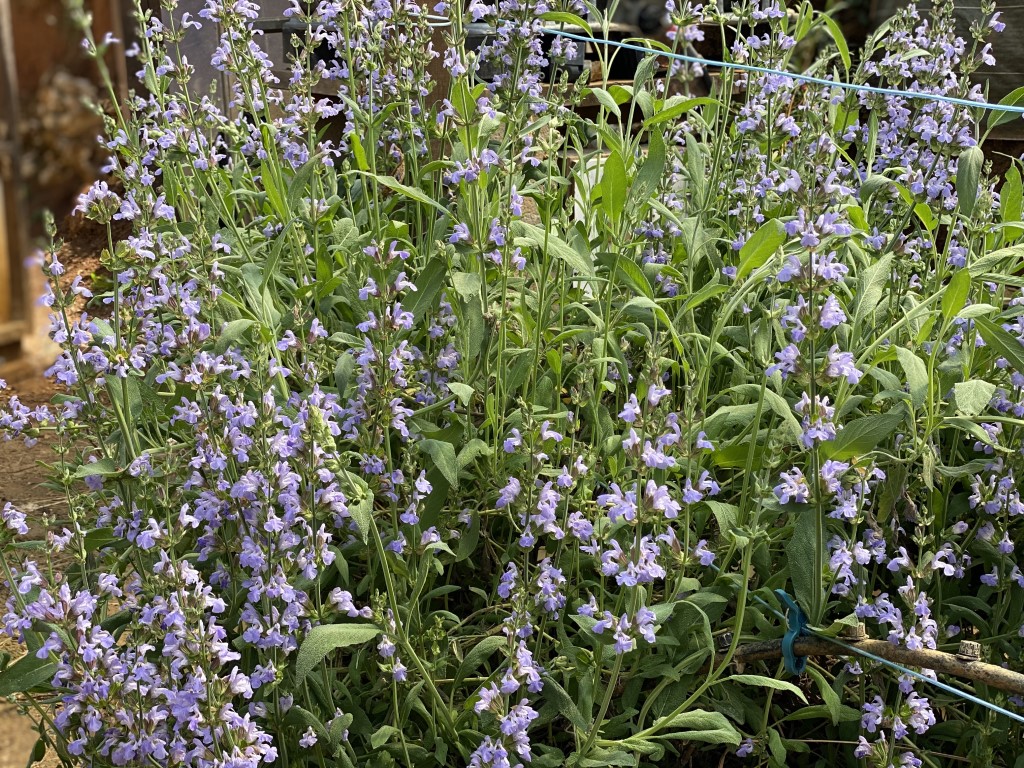
Farming Techniques That Make A Difference
Our Farm
The Land
La Ferme du Bourdicou is a small-scale farm in the Occitanie region of France, covering approximately 2.5 hectares of land (just over 6 acres). The land is divided into several areas where we use different farming techniques. We practice holistic management, so we don’t use synthetic fertilizers, fungicides, pesticides, GMOs or glyphosate.
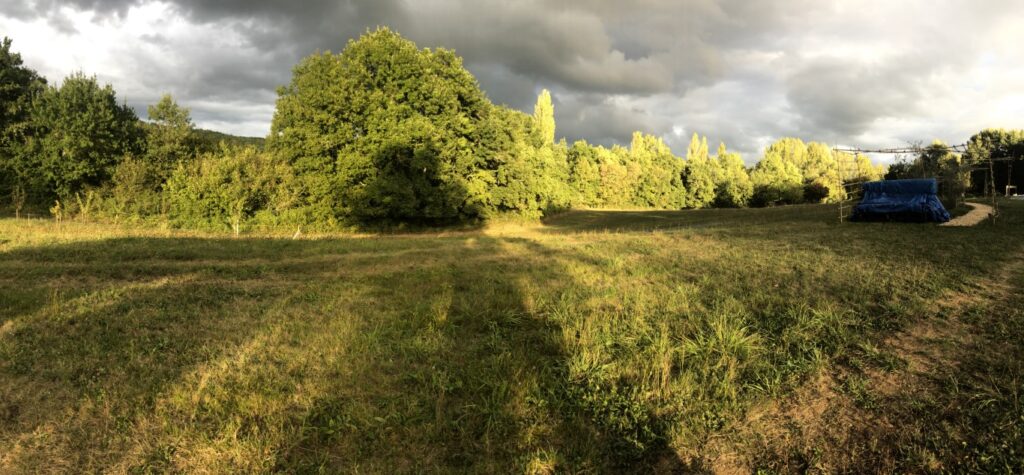
The Animals
Our animals are also an integral part of the farm. The livestock spend their days grazing on a diverse range of plants as they move across the landscape. They enjoy a healthy, stress-free life while regenerating the soil and creating fertile land for us and future generations.
The Goal
Our aim is to be as self-sufficient as possible. At the same time we need to ensure that we sustain the health of the soil, the ecosystems, our animals and our community. Ultimately, we believe that animals and humans can co-exist harmoniously, providing a higher quality of life for all.
At Ferme du Bourdicou, we are all nurtured by nature!
On this page we will provide a brief overview of some of the different areas of the farm and why they are all so important.
Agroforestry
Agroforestry is where woody perennials (trees, shrubs, palms, etc.) are deliberately grown on the same land areas as agricultural crops. The land includes crops such as fruit, nuts, and plants with medicinal properties, but it is also to provide shade, wood products, etc. Traditionally an agroforest is planted and grown as a natural forest with an abundance of mixed vegetation.
At Ferme du Bourdicou, we have messy agroforestry and a pretty one, because some people do not want a natural forest in their garden. So, it is possible to plant a system that provides the same benefits, but looks more structured.
Pretty Agroforestry
Willows have been planted and interspersed with lavender, with the willow branches used to create structures, or even living sculptures. The wonderfully scented lavender is there for the bees and its medicinal properties. Decorative trees, such as oaks, hazelnuts and small bushes, provide shade in the summer and a rich, natural habitat for wildlife.
Once the agroforest has grown to a decent height, with shade and super-heathy soil, we will grow crops amongst the trees and plants. This growth will lessen the need to water the land and help protect the soil, which, in turn, will encourage healthier soil and increase the amount of carbon absorbed into the ground.
Messy Agroforestry
Different trees and shrubs have been planted in the messy agroforestry area. We have selected mainly perennial plants, because their long-lasting roots help to capture more carbon in the soil. In addition, we have planted fruit trees such as apple, mulberry and fig. The diversity of the plants and shrubs has significant advantages – not only will the agroforest provide a variety of fruits, but it will also allow different species of insects, birds and animals to find what they need.
“A journey of a thousand miles begins with a single step”. – Lao Tzu

Self-Sufficient
To be self sufficient means learning to grow your own, make your own and sell your own. Being as independent as possible is the way to go. There is no better time to do this, especially with climate change and the doom and gloom of political and economic uncertainty. Sadly, we have also seen in the last couple of years, just how fragile the global food system is. So being able to grow your own produce is now less of a trend and more a solution.

Eco-friendly
Being eco friendly means living in a way that is not harmful to the environment. This way of life is becoming increasingly important, not only because we need to protect the planet for ourselves, but also for future generations. And it doesn’t matter why you decide to go green. Just remember that every step you take towards living a more considerate and eco-friendly lifestyle is one that can help save the whole world.

Organic
At Ferme du Bourdicou we aim to produce high-quality organic produce, using methods that benefit the whole food system. From plants to people; from animal welfare to the health of the planet. Organic farming means working hard every day to ensure that we sustain the health of the soil, the ecosystems, our animals, people and our community. Organic farming provides countless benefits for nature, wildlife and humanity.
Regenerative Agriculture
Using different techniques, we try to capture as much carbon as possible from the atmosphere. For example, we don’t mow the lawn for several months as this allows different plants to capture carbon and protect the soil from the sun.
The wide variety of plants on the land help feed the soil, and each plant brings a different benefit. But the animals also play a vital role because by grazing them in different areas, their excrement naturally fertilises the soil. Grazing animals also create stress in the plant.
As a result, the plant begins to develop a stronger root system as it strives to grow.
After a few days or weeks, the animals are moved to a new area and only return once the plants have had time to regenerate. Another advantage of this grazing rotation is that it prevents the land from drying out, which can occur when animals are left to graze the same area for too long.
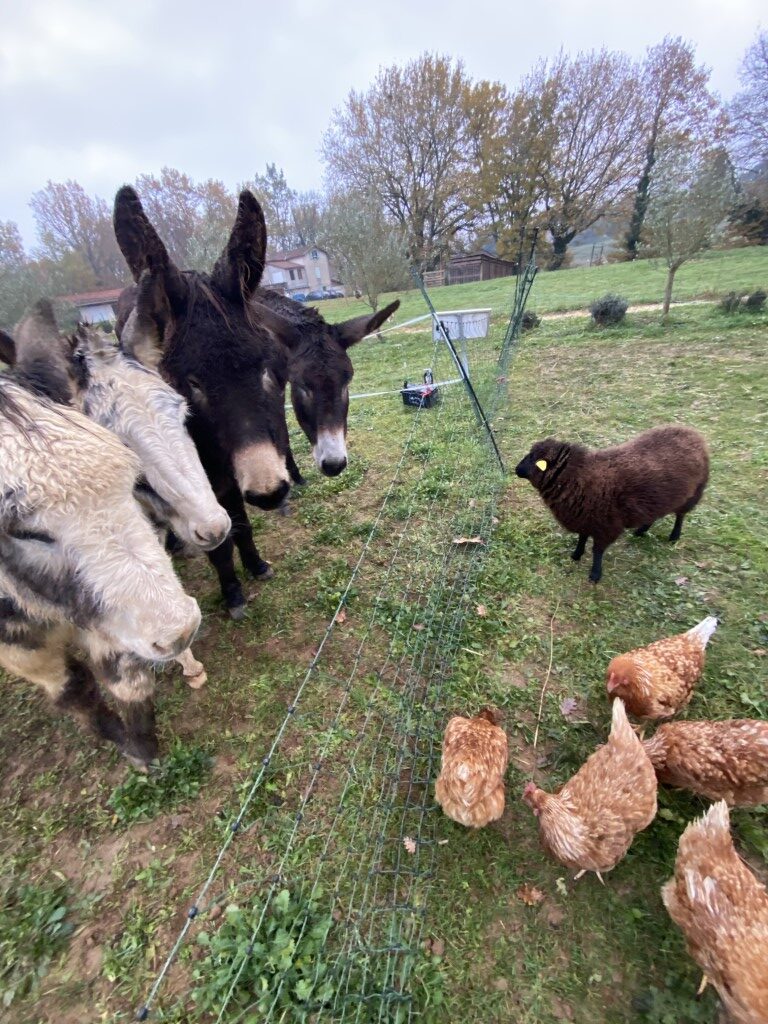

Solar-power
Each area used for grazing is separated by solar-powered, electric fences.
Because the chickens are sometimes in the same pen as the sheep, we take great care to ensure that the fences are suitable for both so they cannot escape.
As you can imagine, moving animals from one plot to another is not always easy. So it is more practical when a few people are involved, and it is also a lot of fun!
We try to attract the sheep by tempting them with food. But we have to go slowly because sudden movements can stress the animals. It is the same with the hens and donkeys – we tread very carefully not to panic them. Thankfully, more often than not, the move does go according to plan.
Pillow Tanks & Water Catchment Bins
Our farm needs a lot of water for both the animals and the plants. The donkeys drink large quantities of water, so we collect and store as much rain water as possible to use all year round.
Next to the house, in the middle of the land and near the donkey shelter, we have installed pillow tanks – large flexible bags that fill with water when it rains.
The tanks capture rainwater from the cottage and donkey shelter roofs, whilst the one in the middle of the land is for the overflow and water for the messy agroforestry.
The water catchment bins collect the water from the roofs of the animals shelters. Most of these bins contain goldfish that feed exclusively on mosquito larvae. Plants have also been installed in some of the tanks to help improve the water quality.
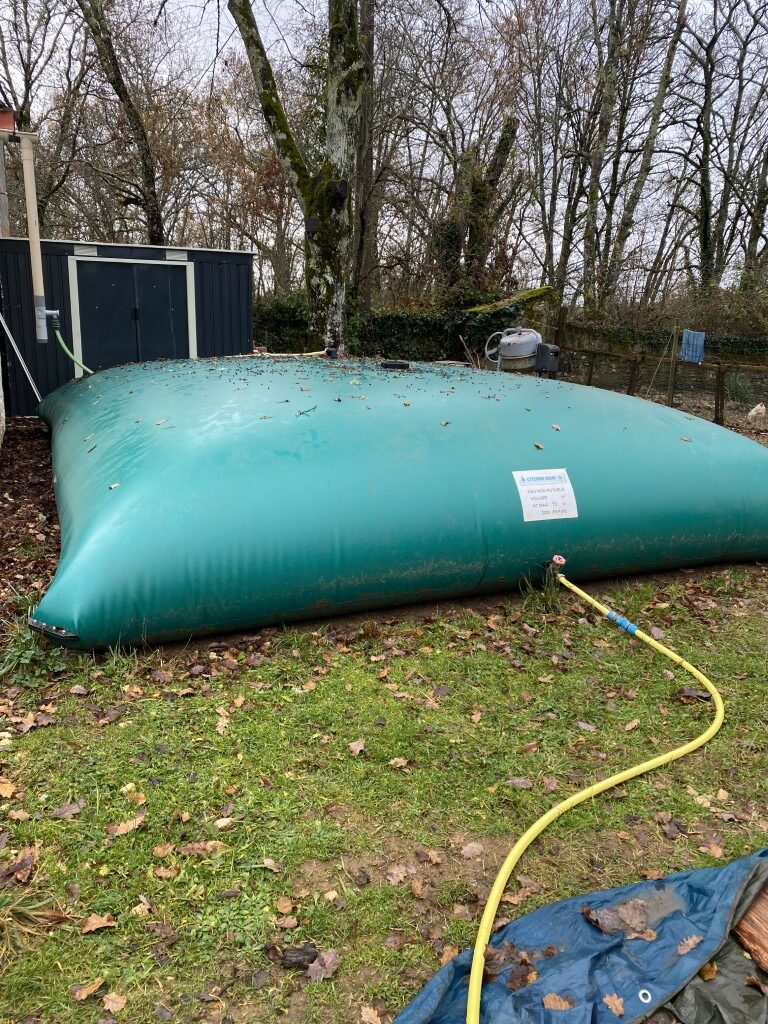
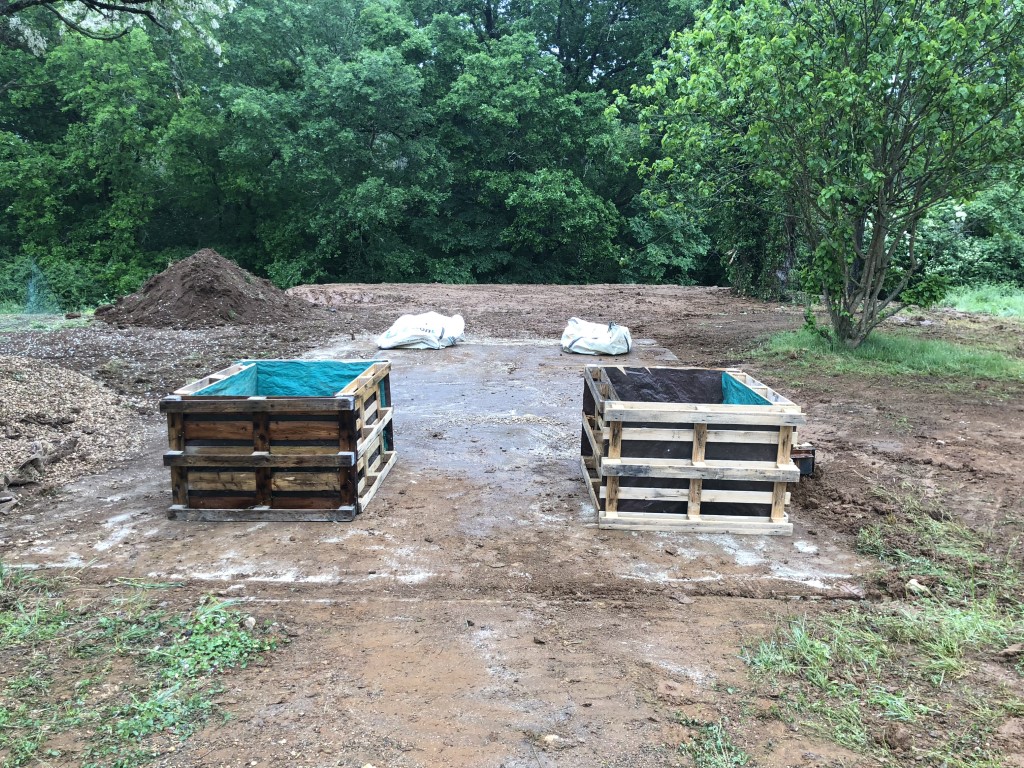
Raised Beds
Our raised beds are built from reclaimed wooden pallets. Being raised, the beds are slightly warmer (between 8 to 13 degrees) compared to the soil temperature below them. So this means we can use them for planting earlier in the year. Raised beds are also a great space-saver, because you can grow plants on the sides of the containers. Planted densely, raised beds create good soil cover, retain moisture and prevent unwanted weed growth.
Hot Compost – after just 28 days!
We use different layers of garden and animal waste, plus other compostable materials, to create our very own “hot compost”.
Chicken manure, straw, green leaves, plants and layers of egg cartons create air, which is kept slightly moist (but not too wet) and turned over everyday to aerate it. This aerobic process (using oxygen) does not produce any smelly odours. Then, after 28 days, the materials have decomposed, and the hot compost is ready to be used.
The Cob House Chicken Coop
Our Cob House is made from the soil dug out from the walipini and a mixture of clay soil and chopped straw. This is a very old, naturally organic building material called ‘cob’, which has experienced a revival in recent years as a form of sustainable construction.
The roof structure is made from bamboo, inserted into a tyre to strengthen the centre core of the building. Recycled glass bottles create small halos of light through the walls, and reclaimed toilets have been added for the chickens to lay their eggs in. They also have a bamboo perch which they like to sleep on, snuggled up against the other.
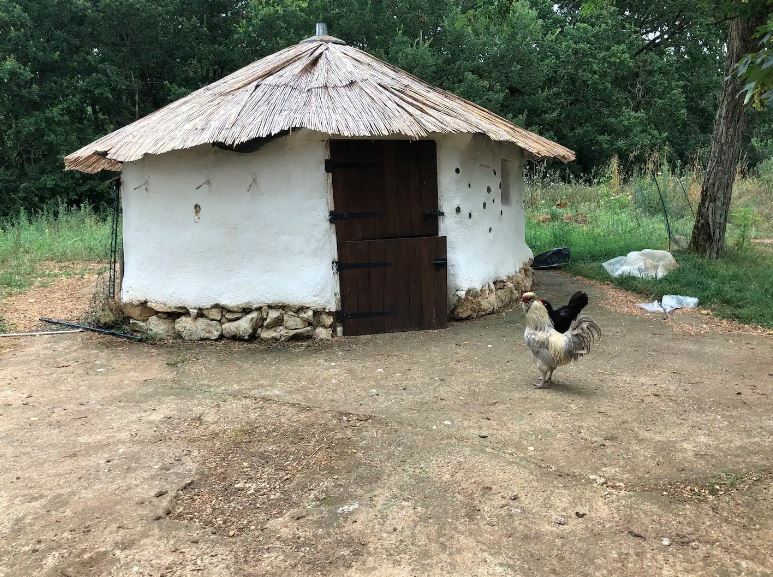

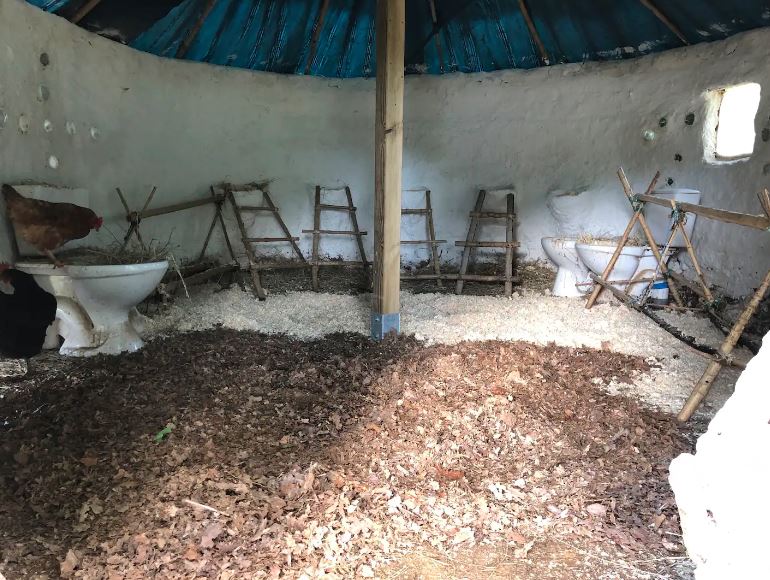
Come & Stay at La Ferme du Bourdicou
Create wonderful family memories that will last a lifetime. Stay in our luxury self-catering gite, La Bergerie at Bourdicou. Surrounded by nature and wildlife, our gite is the perfect place to relax and unwind with family and friends. Help out on the farm, feeding, cleaning and getting to know all our animals. Or enjoy some peaceful solitude in one of the many quiet areas on the land. Do as much or as little as you like….